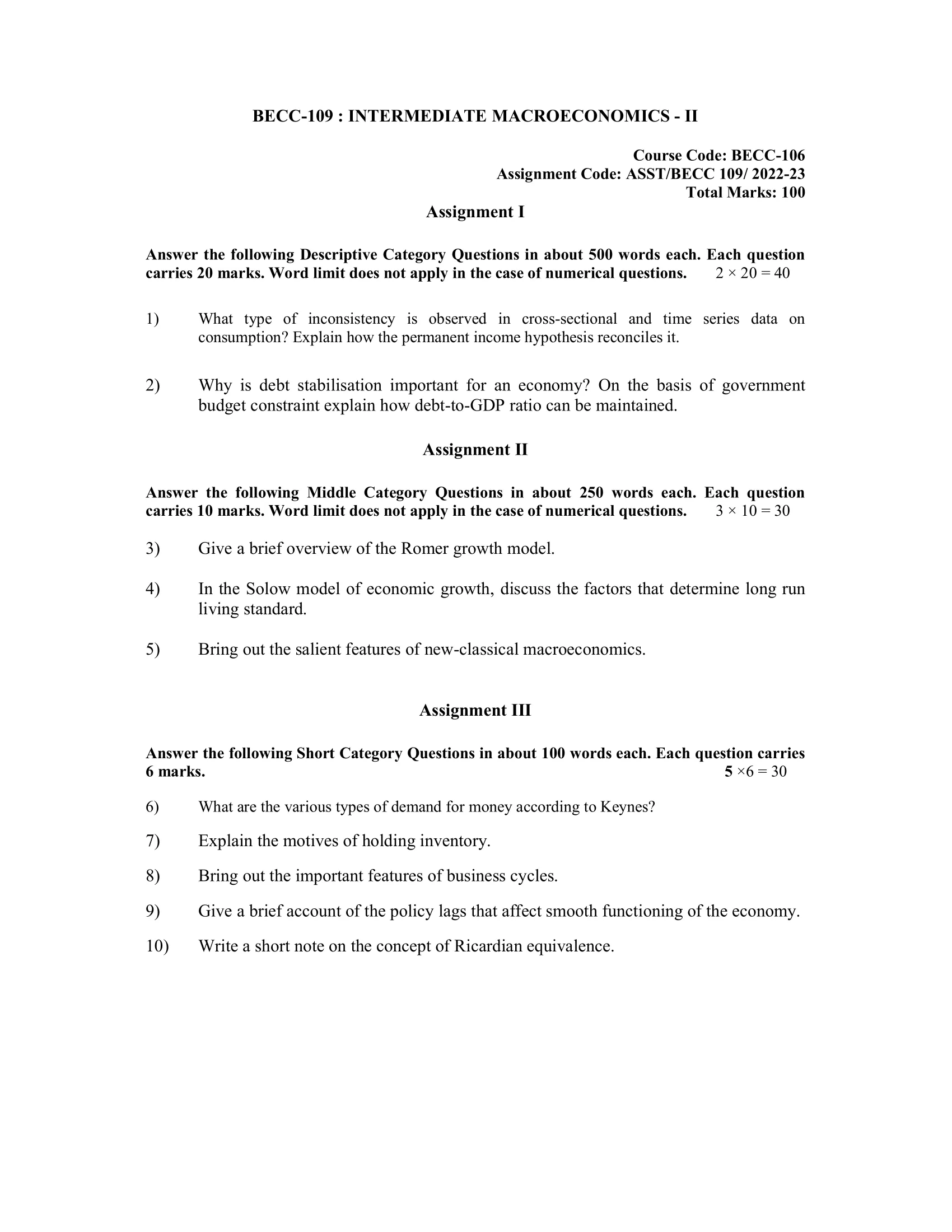Contents
- 1 Assignment I
- 2 Answer the following Descriptive Category Questions in about 500 words each. Each question carries 20 marks. Word limit does not apply in the case of numerical questions.
- 3 1) What type of inconsistency is observed in cross-sectional and time series data onconsumption? Explain how the permanent income hypothesis reconciles it.
- 4 2) Why is debt stabilisation important for an economy? On the basis of governmentbudget constraint explain how debt-to-GDP ratio can be maintained.
- 5 Assignment II
- 6 Answer the following Middle Category Questions in about 250 words each. Each question carries 10 marks. Word limit does not apply in the case of numerical questions.
- 7 3) Give a brief overview of the Romer growth model.
- 8 4) In the Solow model of economic growth, discuss the factors that determine long runliving standard.
- 9 5) Bring out the salient features of new-classical macroeconomics.
- 10 Assignment III
- 11 Answer the following Short Category Questions in about 100 words each. Each question carries 6 marks.
- 12 6) What are the various types of demand for money according to Keynes?
- 13 7) Explain the motives of holding inventory.
- 14 8) Bring out the important features of business cycles.
- 15 9) Give a brief account of the policy lags that affect smooth functioning of the economy.
- 16 10) Write a short note on the concept of Ricardian equivalence.

| Title | BECC-109 |
| University | IGNOU |
| Degree | Bachelor Degree Programme |
| Course Code | BECC-109 |
| Course Name | INTERMEDIATE MACROECONOMICS-II |
| Programme Name | Bachelor of Arts (General) |
| Programme Code | BAG |
| Total Marks | 100 |
| Year | 2022-2023 |
| Language | English |
| Assignment Code | ASST/BECC 109/2022-23 |
| Last Date for Submission of Assignment: | For June Examination: 31st April For December Examination: 30th September |

Assignment I
Answer the following Descriptive Category Questions in about 500 words each. Each question carries 20 marks. Word limit does not apply in the case of numerical questions.
1) What type of inconsistency is observed in cross-sectional and time series data on
consumption? Explain how the permanent income hypothesis reconciles it.
Ans: Inconsistency in cross-sectional and time series data on consumption refers to the conflicting results that can be obtained from analyzing these two different types of data sets. Cross-sectional data refers to data collected from a sample of individuals at a specific point in time, while time series data refers to data collected from the same individuals over an extended period of time.
One common type of inconsistency observed in cross-sectional data on consumption is that individuals with higher income tend to have higher levels of consumption. However, when analyzing time series data, it has been found that individual consumption does not always increase proportionally with increases in income. This has led to the question of why individuals do not consume all of their income, and the permanent income hypothesis was developed to reconcile this inconsistency.
The permanent income hypothesis states that individuals make consumption decisions based on their permanent income, rather than their current income. Permanent income refers to an individual’s expected long-term average income, taking into account any expected changes in income due to factors such as career progression, inflation, and other economic factors. According to the permanent income hypothesis, individuals will adjust their consumption levels to align with their permanent income, rather than their current income.
For example, if an individual expects their income to increase in the future, they may not increase their consumption levels proportionally with their current income. Instead, they may save a portion of their current income, in order to maintain their desired level of consumption in the future, when their expected income has increased. This can result in lower levels of consumption in the short-term, even though the individual’s income has increased.
The permanent income hypothesis can also help to reconcile the inconsistencies observed in cross-sectional and time series data on consumption by taking into account the fact that individuals face uncertainty in their income and consumption decisions. In reality, individuals may not have a clear understanding of their permanent income, and may have to make consumption decisions based on their best estimate of what their permanent income will be. This can result in deviations from the predictions of the permanent income hypothesis, and explain why some individuals may consume more or less than what would be expected based on their income.
2) Why is debt stabilisation important for an economy? On the basis of government
budget constraint explain how debt-to-GDP ratio can be maintained.
Ans: Debt stabilisation is important for an economy because it helps to ensure that the government is able to meet its financial obligations and maintain investor confidence in the economy. High levels of government debt can lead to concerns about the government’s ability to repay its debts, and can result in higher borrowing costs for the government and increased financial instability.
The government budget constraint is a fundamental concept in economics that states that the government must balance its spending with its revenue. The government budget constraint can be represented as:
Government Spending + Government Debt = Government Revenue
The debt-to-GDP ratio is a measure of the government’s debt relative to the size of the economy. Maintaining a stable debt-to-GDP ratio is important for ensuring that the government’s debt is sustainable over the long term.
One way to maintain the debt-to-GDP ratio is for the government to adjust its spending and revenue levels so that they are in balance over the long term. For example, if the government increases its spending, it may need to increase its revenue by increasing taxes or borrowing more. If the government borrows more, it will increase its debt and increase the debt-to-GDP ratio.
Another way to maintain the debt-to-GDP ratio is for the government to implement fiscal policies that promote economic growth. A growing economy will increase the size of the economy and lower the debt-to-GDP ratio, as the debt will be spread over a larger economic base. For example, the government may invest in infrastructure or education, which can increase the productivity of the economy and promote economic growth.
Additionally, the government can implement structural reforms that increase its revenue and reduce its spending. For example, the government may improve tax collection processes or reduce inefficient spending. These reforms can increase the government’s revenue and reduce its spending, helping to maintain the debt-to-GDP ratio.
Assignment II
Answer the following Middle Category Questions in about 250 words each. Each question carries 10 marks. Word limit does not apply in the case of numerical questions.
3) Give a brief overview of the Romer growth model.
Ans: The Romer growth model, developed by economist Paul M. Romer in 1986, is a theoretical framework that explains how technological progress drives economic growth. According to the model, technological progress can be divided into two categories: embodied and disembodied. Embodied technological progress refers to the introduction of new capital goods or machines that embody new technologies, while disembodied technological progress refers to the discovery of new ideas or knowledge.
The Romer growth model argues that technological progress is the primary driver of economic growth, and that this progress is the result of investments in research and development (R&D). In the model, R&D generates new ideas and knowledge, which can then be used to create new products, processes, and technologies. The model also highlights the positive feedback loop between technological progress and economic growth. As the economy grows, there is more demand for new goods and services, which drives further investments in R&D and technological progress.
One of the key insights of the Romer growth model is that technological progress is non-rivalrous and non-excludable. This means that once a new idea or knowledge has been created, it can be used by multiple firms without reducing its value, and it is difficult to prevent others from using it. This has important implications for policy, as it suggests that investment in R&D and education can have positive spillover effects for the entire economy.
Another important contribution of the Romer growth model is the concept of “increasing returns to scale”. According to this concept, as more resources are invested in R&D, the returns from technological progress increase, which can lead to explosive growth in the economy.
4) In the Solow model of economic growth, discuss the factors that determine long run
living standard.
Ans: The Solow model of economic growth is a widely-used framework for analyzing long-run economic growth. It focuses on the factors that determine a country’s level of output per capita and long-run living standard.
According to the Solow model, long-run living standards are determined by two factors: the level of technological progress and the accumulation of physical capital. Technological progress is assumed to be exogenous, meaning that it is determined outside of the model and is not influenced by economic conditions. The accumulation of physical capital, on the other hand, is influenced by savings and investment decisions made by households and firms.
The model shows that an increase in the level of technological progress or an increase in the accumulation of physical capital leads to an increase in the economy’s level of output per capita, which in turn raises living standards. Conversely, a decrease in either of these factors will lead to a decrease in living standards.
Another factor that determines living standards in the Solow model is the rate of population growth. An increase in the population growth rate will reduce the level of output per capita, which will lower living standards.
Finally, the model also shows that there are diminishing returns to capital, meaning that as a country accumulates more physical capital, the rate of growth in output per capita will gradually slow down. This implies that a country’s living standards will eventually converge towards a steady state level, even in the absence of technological progress or population growth.
5) Bring out the salient features of new-classical macroeconomics.
Ans: New classical macroeconomics is a macroeconomic theory that emerged in the late 1970s and early 1980s as a response to the failures of Keynesian macroeconomics. It is based on the idea that macroeconomic models should be built on microeconomic foundations and that the behavior of individual economic agents, such as households and firms, should play a central role in explaining macroeconomic phenomena.
One of the main features of new classical macroeconomics is its emphasis on rational expectations. According to this theory, individuals and firms form their expectations about the future based on all available information, and these expectations influence their behavior. For example, if individuals expect that the economy will experience inflation in the future, they may adjust their behavior accordingly, such as by demanding higher wages.
Another important feature of new classical macroeconomics is its focus on the efficient functioning of markets. The theory assumes that markets are competitive and that prices adjust quickly to bring supply and demand into balance. This means that, in the long run, the economy will tend towards a natural rate of unemployment, which is determined by the interaction of supply and demand in the labor market.
New classical macroeconomics also stresses the importance of nominal rigidity, which refers to the difficulty that prices and wages have in adjusting to changes in the economy. According to this theory, nominal rigidity can lead to persistent deviations from the natural rate of unemployment and to macroeconomic phenomena such as business cycles.
Finally, new classical macroeconomics highlights the role of monetary policy in the economy. The theory argues that monetary policy can have real effects on the economy by affecting the expectations of individuals and firms, and that it is therefore an important tool for stabilizing the economy.
Assignment III
Answer the following Short Category Questions in about 100 words each. Each question carries 6 marks.
6) What are the various types of demand for money according to Keynes?
Ans: John Maynard Keynes identified three types of demand for money: the transactions demand for money, the speculative demand for money, and the precautionary demand for money.
- Transactions demand for money refers to the demand for money as a medium of exchange to facilitate transactions in goods and services. It is the demand for money to pay for everyday expenses such as food, housing, and transportation.
- Speculative demand for money refers to the demand for money as a store of value. This is the demand for money to hold as a financial asset, with the expectation that it will maintain its value over time or even appreciate in value.
- Precautionary demand for money refers to the demand for money as a means of reducing the risk of unexpected events. This is the demand for money to hold as a cushion against emergencies or unforeseen expenses, such as job loss or medical bills.
Each of these three types of demand for money can change in response to different economic and financial conditions, and each can have an impact on overall demand for money and the economy as a whole. Understanding the different types of demand for money is important for analyzing monetary policy and the behavior of economic agents.
7) Explain the motives of holding inventory.
Ans: There are several motives for holding inventory, including:
- Meeting customer demand: Businesses hold inventory to ensure that they have sufficient quantities of goods on hand to meet customer demand. This is particularly important for businesses that operate in industries with fluctuating demand or for businesses that sell products with long lead times.
- Smooth production: Holding inventory can help businesses to smooth out fluctuations in production and avoid production bottlenecks. By holding inventory, businesses can ensure that they have sufficient raw materials and components on hand to continue production even if there are temporary disruptions to the supply chain.
- Averting stock-outs: Inventory can help businesses to avoid stock-outs, which can lead to lost sales and damage to customer relationships. By holding sufficient inventory, businesses can ensure that they have the products they need to meet customer demand and avoid stock-outs.
- Taking advantage of bulk purchasing discounts: By holding inventory, businesses can take advantage of bulk purchasing discounts offered by suppliers. By purchasing larger quantities of goods, businesses can reduce their average costs and increase their profitability.
- Managing uncertainty: Holding inventory can help businesses to manage uncertainty by providing a buffer against fluctuations in demand and supply. By holding inventory, businesses can ensure that they have the products they need to meet customer demand even if there are unexpected changes in the market.
8) Bring out the important features of business cycles.
Ans: Business cycles are fluctuations in economic activity characterized by periods of expansion and contraction. The following are the important features of business cycles:
- Regularity: Business cycles tend to follow a regular pattern, with periods of expansion and contraction occurring at regular intervals. This regularity has been observed in many economies across the world over many decades, making it a well-established phenomenon.
- Duration: Business cycles tend to last for several years, with expansions typically lasting for several years and contractions lasting for a shorter period of time. The length of the business cycle can vary from one cycle to another and can be influenced by a range of economic and political factors.
- Phases: Business cycles typically have four distinct phases: expansion, peak, contraction, and trough. During the expansion phase, economic activity is increasing, while during the contraction phase, it is declining. The peak marks the end of the expansion phase, while the trough marks the end of the contraction phase.
- Amplitude: Business cycles can vary in their amplitude, or the degree of fluctuation in economic activity. Some business cycles can be relatively mild, with only a small change in economic activity, while others can be severe, with a large change in economic activity.
- Interdependence: Business cycles are interdependent, meaning that they are closely linked to each other across different sectors of the economy. A change in economic activity in one sector can impact economic activity in other sectors, leading to a broader impact on the economy as a whole.
- International influence: Business cycles are not limited to one economy, but can have an impact on the global economy. Changes in economic activity in one country can impact economic activity in other countries, leading to a global business cycle.
9) Give a brief account of the policy lags that affect smooth functioning of the economy.
Ans: Policy lags refer to the time that elapses between the implementation of a policy and its impact on the economy. Policy lags can have a significant impact on the smooth functioning of an economy and can lead to unintended consequences. The following are the main types of policy lags that affect the smooth functioning of the economy:
- Recognition lag: The recognition lag is the time that elapses between the onset of a problem in the economy and the recognition by policymakers that a policy response is needed. If policymakers are slow to recognize a problem, they may delay the implementation of a policy that could have prevented or mitigated the problem.
- Decision lag: The decision lag is the time that elapses between the recognition of a problem and the decision to implement a policy response. This lag can be caused by a variety of factors, including political considerations, disagreements among policymakers, and the complexity of the policy itself.
- Implementation lag: The implementation lag is the time that elapses between the decision to implement a policy and the actual implementation of the policy. This lag can be caused by a variety of factors, including the time it takes to design and implement the policy, the time it takes to gain approval from relevant authorities, and the time it takes to implement the policy in practice.
- Effectiveness lag: The effectiveness lag is the time that elapses between the implementation of a policy and its impact on the economy. This lag can be caused by a variety of factors, including the time it takes for the policy to take effect, the time it takes for businesses and households to adjust to the policy, and the time it takes for the policy to be transmitted through the economy.
10) Write a short note on the concept of Ricardian equivalence.
Ans: Ricardian equivalence is an economic concept named after the 19th-century economist David Ricardo. It states that changes in government borrowing or changes in the tax system have no effect on the economy because individuals understand that the government will eventually have to finance its spending through future taxes.
Under Ricardian equivalence, consumers and investors respond to an increase in government borrowing by saving more, as they expect that future taxes will have to be increased to pay off the debt. This increased saving offsets the increase in spending from the government’s borrowing, leading to no change in overall demand and no impact on the economy.
The idea of Ricardian equivalence challenges the traditional view that changes in government spending and taxation can have a stimulative or contractionary effect on the economy. Instead, it suggests that such changes are largely neutral and do not have a significant impact on the economy.
Critics of Ricardian equivalence argue that the theory assumes that individuals have perfect information about future tax rates, which is not the case in reality. Furthermore, they argue that the theory does not account for the impact of government spending on the distribution of income, which can have important effects on the economy.
How to Download BECC-109 Solved Assignment?
You can download it from the www.edukar.in, they have a big database for all the IGNOU solved assignments.
Is the BECC-109 Solved Assignment Free?
Yes this is absolutely free to download the solved assignment from www.edukar.in
What is the last submission date for BECC-109 Solved Assignment?
For June Examination: 31st April, For December Examination: 30th October
















